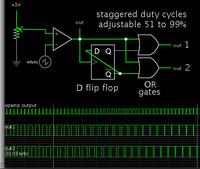aamir
Junior Member level 2
Can we use n-channel mosfet on low side in buck converter instead of high side for simplicity as shown in image because in this case we can directly drive mosfet from pwm ic with minimum losses and heat.if its ok then what should be the inductor value for an output of 12-14 volts 20 amps having switching frequency of 30 khz?thanks in advance to all helping friends.
- - - Updated - - -
Here is the image
- - - Updated - - -
Here is the image






